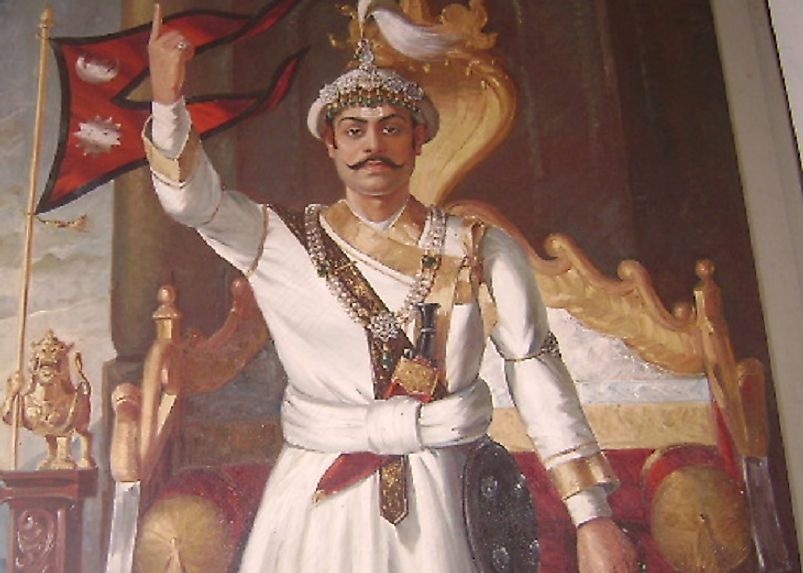Kingdom Of Nepal (Gorkha)

The Kingdom of Nepal was founded in 1768 by King Prithvi Narayan Shah, who hailed from the Gorkha Kingdom. The kingdom lasted for 240 years before the abolition of the Nepalese Monarchy in 2008. During the monarchical period, Nepal was ruled by Shah Dynasty which ruled with the different degree of power. The Kingdom of Nepal considered Hinduism as the state religion until the kingdom was abolished. Currently the country is a secular state with all religions treated as equal.
5. Nepal Before and After Unification
The history of Nepal began with the arrival of the Kiratis in the Kathmandu Valley in the 7th and 8th Centuries. The Kirats ruled the Valley for 1225 years with 28 kings leading the kingdom over that period. Nepal became a political region which was united by kings or rulers of different kingdoms. One of the kings who played a critical role in the unification of Nepal was Prithvi Narayan Shah who ascended to the throne of Gorkha kingdom in 1743. His political ambitions saw him unite smaller kingdoms and capture such places as Nuwakot, Lamjung, Tanahun, Kirtipur, and Makawanpur through treaties and military conquest. King Prithvi Narayan Shah named his territory Kingdom of Gorkha but the name was changed to the Kingdom of Nepal in 1930 by King TribhuvanBir Bikram Shah.
4. Chinese and British Influences
The Chinese and the British played a significant role in the actions and policies of the Kingdom of Nepal throughout its existence. Nepal was a tributary state of the Chinese Empire after the failed invasion of Tibet in 1790s. Nepal became the de facto protectorate of British after the Anglo-Nepalese War with British controlling much of the Nepalese territories. The British influenced the activities of the Rana Dynasty who kept away the king from the activities of the state.
3. Foreign Wars and Domestic Strife
In the 19th Century, the rivalry between Nepal and India led to the Anglo-Nepalese War, which lasted from 1814 until 1816. Nepalese were defeated in this war leading to the signing of the Sugauli Treaty with the kingdom retaining its independence but under the de facto protectorate under the British. Internally, the monarch’s authoritarian regime and curbing of political parties in Nepal coupled with accusation of misappropriation of funds led to political agitation in the country especially in 1992. The civil strife between the civilians and the police led to the death of two activists with several injured. In 1996, the Nepalese Civil War which contributed to the abolition of the monarch erupted with Maoist parties actively involved in the war.
2. Abolition of the Monarchy and Establishment of the Republic of Nepal
The abolition of the king's powers began during the civil war of 1996, when a Maoist-influenced party initiated a process to remove the Parliamentary Monarchy system. The Maoist strategy, which was known as the People’s War, was led by Dr Baburam Bhattarai. In 2001, the Royal Massacre further escalated the Maoist rebellion despite the king’s effort to take full control of the government. The unstable government and the sustained siege by the Maoist weakened the Monarch with King Gyanendra declaring the kingdom’s state of emergency and putting several politicians under arrest on February 1, 2005. In April of 2006, the king reestablish parliament. A coalition of parties subsequently took over the government and reduced the powers of the king. On December 24, 2007, the Nepalese Constituent Assembly was established which made way to the abolition of monarchy with Nepal declared a Federal Democratic Republic on May 28, 2008.
1. Historical Legacy of the Former Kingdom
Much of the territory of the current Republic of Nepal was acquired and shaped as a result of the activities and the conquests of the Kingdom of Nepal. King Prithvi Narayan Shah managed to rescue the smaller kingdoms which were becoming weaker due to the internal conflicts and battles. He united these kingdoms into one stronger kingdom which lasted 240 years. The former kingdom also valued some of the traditions that continue to be helped by Nepalese today.







